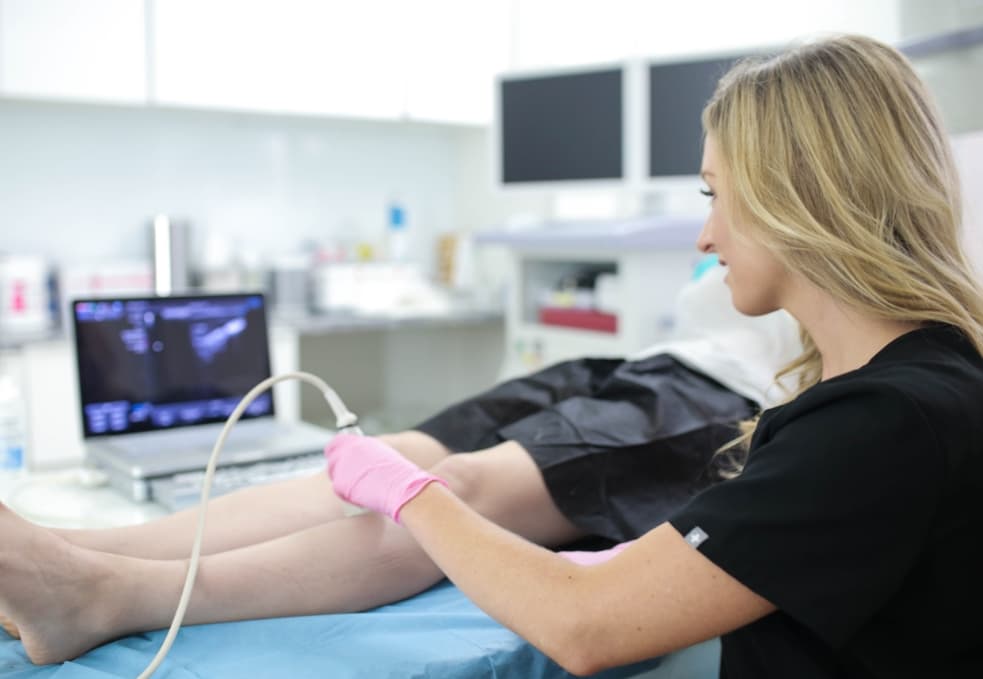The Best Vein Treatment in Long Island
Our medical centers for vein treatment in Long Island specialize in the latest and safest minimally invasive treatments for spider veins, varicose veins, and chronic venous insufficiency. If you’re looking for the best vein center or a vein treatment clinic, we encourage you to visit our medical centers for vein treatment in Lindenhurst, Jericho, or Hampton Bay in Long Island. Our board-certified vein doctors always perform thorough diagnostic tests and evaluations to identify and treat the root cause of varicose veins — not just the symptoms. Our comprehensive approach to varicose vein treatment ensures long-lasting results with minimal risk of vein disease recurrence. If you have spider veins or varicose veins, please schedule an appointment at our medical centers for vein treatment in Long Island.
We provide a step-by-step guide to spider vein and varicose vein treatments in Long Island.
Step 1: Initial Consultation
Your varicose vein treatment starts with an initial consultation at our medical centers for vein treatment. The vein doctor will examine your leg veins, discuss your symptoms, and review your medical history. Varicose veins are easily diagnosed — they’re dense blood vessels that bulge out of the skin’s surface. But it’s not enough to identify varicose veins — the vein doctor must also diagnose chronic venous insufficiency, the circulatory disorder responsible for most of your vein problems. Treating varicose veins without addressing the root cause would lead to a high risk of recurrence, which we like to avoid.
Step 2: Vascular Imaging
After a thorough physical examination, the vein doctor will administer vascular imaging tests. We perform duplex ultrasound, one of the most reliable tests for chronic venous insufficiency. During the duplex ultrasound scan, the ultrasound technician uses a handheld device to channel ultrasound energy into your legs, providing a visual of the blood flow in your leg veins on a computer screen. The vein doctor interprets the duplex ultrasound results to determine if you truly have chronic venous insufficiency. The duplex ultrasound results can also support your insurance claims, helping you get optimal insurance coverage for your treatment.
Step 3: Treatment Plan
The vein doctor curates a personalized vein treatment plan after a thorough diagnosis. If you have chronic venous insufficiency, the vein doctor will first address the root cause of your conditions and then remove the superficial varicose veins. However, varicose vein removal can be performed using multiple methods. The vein doctor will discuss the unique pros and cons of all treatment options, giving you all the information you need to make an informed decision about your vein treatment. The vein doctor will also recommend the ideal treatment based on your symptoms, diagnostic results, medical history, insurance coverage options, and lifestyle.
Step 4: Primary Vein Treatment
If you have chronic venous insufficiency, your vein treatment will start with radiofrequency ablation, laser ablation, or venaseal. These minimally invasive procedures destroy the diseased saphenous vein responsible for most of your vein problems, rerouting the accumulated blood into healthier leg veins. Below, we describe the best vein treatments for chronic venous insufficiency.
Radiofrequency Ablation
Radiofrequency ablation involves using a catheter to channel thermal energy and collapse the diseased saphenous vein responsible for your vein problems. The diseased vein is eventually absorbed by the body, and the accumulated blood reroutes into healthier leg veins.
Laser Ablation
Laser ablation involves driving a laser fiber into a diseased vein and activating it to generate laser energy, which collapses the diseased saphenous vein, facilitating its absorption by the body. The accumulated blood reroutes into healthier leg veins.
VenaSeal
VenaSeal is a minimally invasive procedure that involves injecting a medical-grade adhesive into the diseased saphenous vein. The vein glue seals the diseased vein’s walls, turning it into a hardened tissue eventually absorbed by the body. The accumulated blood reroutes into healthier veins.
Step 5: Varicose Vein Removal
After treating chronic venous insufficiency, the vein doctor can focus on the removal of superficial varicose veins. Ambulatory phlebectomy is one of the most effective minimally invasive procedures for superficial varicose veins. After administering local anesthesia, the vein doctor makes small incisions on the skin’s surface to physically extract the superficial varicose veins. The incisions eventually heal into scars that fade away from the skin’s surface. The treatment concludes within an hour, following which you can resume your daily activities.
In addition to varicose veins, you may also need sclerotherapy if you have spider veins. Sclerotherapy is a minimally invasive procedure wherein the vein doctor injects a sclerosant medicine into the unhealthy spider veins. The sclerosant medicine seals the spider veins’ walls, turning them into hardened scar tissues that eventually shrink and get absorbed by the body. The spider veins eventually fade away from the skin’s surface within three weeks. Sclerotherapy only removes spider veins — not varicose veins.
Step 6: Recovery & Aftercare
Minimally invasive spider vein and varicose vein treatments conclude within an hour, following which you can resume most of your daily activities and work. However, you should avoid strenuous workouts, saunas, hot showers, and direct sunlight for a few days. You should also wear compression stockings to push blood towards the heart and prevent vein disease recurrence. If you follow the vein doctor’s aftercare guidelines, you should have no problems. If you’re concerned about your superficial varicose veins, please contact our vein doctors today.
